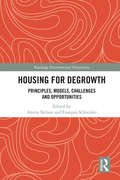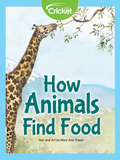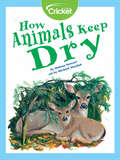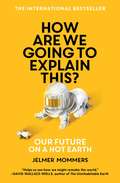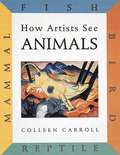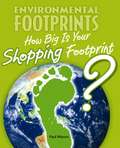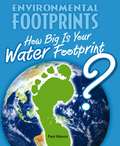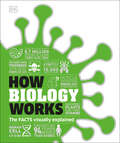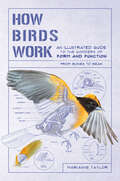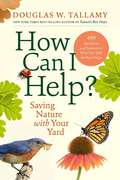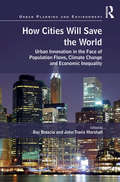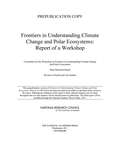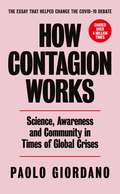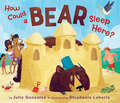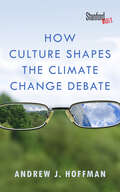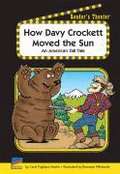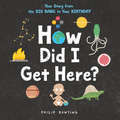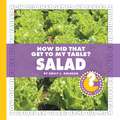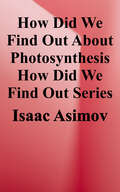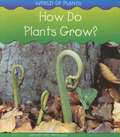- Table View
- List View
Housing for Degrowth: Principles, Models, Challenges and Opportunities (Routledge Environmental Humanities)
by Anitra Nelson François Schneider‘Degrowth’, a type of ‘postgrowth’, is becoming a strong political, practical and cultural movement for downscaling and transforming societies beyond capitalist growth and non-capitalist productivism to achieve global sustainability and satisfy everyone’s basic needs. This groundbreaking collection on housing for degrowth addresses key challenges of unaffordable, unsustainable and anti-social housing today, including going beyond struggles for a 'right to the city' to a 'right to metabolism', advocating refurbishment versus demolition, and revealing controversies within the degrowth movement on urbanisation, decentralisation and open localism. International case studies show how housing for degrowth is based on sufficiency and conviviality, living a ‘one planet lifestyle’ with a common ecological footprint. This book explores environmental, cultural and economic housing and planning issues from interdisciplinary perspectives such as urbanism, ecological economics, environmental justice, housing studies and policy, planning studies and policy, sustainability studies, political ecology, social change and degrowth. It will appeal to students and scholars across a wide range of disciplines.
How A Seed Grows
by Helene J. JordanHow does a tiny acorn grow into an enormous oak tree? With beautiful and accurate watercolor illustrations from Loretta Krupinski, this book by Helene Jordan traces the process of how a little seed grows into the plants and trees that surround us.
How Animal Babies Stay Safe (Let's-Read-and-Find-Out Science 1)
by Mary Ann FraserRead and find out about how animal parents keep their babies safe from predators in this colorfully illustrated nonfiction picture book.This is a clear and appealing science book for early elementary age kids, both at home and in the classroom. It looks at the many strategies animal babies use to survive in a dangerous world. Some babies hide in nests or dens, some ride on thier parents' back or in their pouches, some use camouflage, and some rely on their parents' sharp claws and teeth to fend off enemies. Whether showing "a mother monkey swinging through the jungle with her baby on her back or two baby raccoons peeking out of their tree-house home while their mother lures a bobcat away from her young," wrote Kirkus, this book captures the eternal appeal of baby animals.It's a Level 1 Let's-Read-and-Find-Out, which means the book explores introductory concepts perfect for children in the primary grades. The 100+ titles in this leading nonfiction series are:hands-on and visualacclaimed and trustedgreat for classroomsTop 10 reasons to love LRFOs:Entertain and educate at the same timeHave appealing, child-centered topicsDevelopmentally appropriate for emerging readersFocused; answering questions instead of using survey approachEmploy engaging picture book quality illustrationsUse simple charts and graphics to improve visual literacy skillsFeature hands-on activities to engage young scientistsMeet national science education standardsWritten/illustrated by award-winning authors/illustrators & vetted by an expert in the fieldOver 130 titles in print, meeting a wide range of kids' scientific interestsBooks in this series support the Common Core Learning Standards, Next Generation Science Standards, and the Science, Technology, Engineering, and Math (STEM) standards. Let's-Read-and-Find-Out is the winner of the American Association for the Advancement of Science/Subaru Science Books & Films Prize for Outstanding Science Series.
How Animals Find Food
by Mary Ann FraserAnimals get their energy from the food they eat. Animals depend on other living things for food. Some animals, called herbivores, eat plants; while others are carnivores that eat other animals. Scavengers, like vultures and hyenas, eat dead animals. Learn how different animals eat and how this determines how they look and where they live. Can you name other animals that are scavengers?
How Animals Keep Dry
by Melissa StewartMany animals take cover when it rains. They like to stay warm and dry too!
How Are We Going to Explain This?: Our Future on a Hot Earth
by Jelmer MommersThere&’s a new story in the making, one in which the consequences of our actions add up—and every contribution is meaningful.If climate change is the biggest threat humanity has ever faced, then why are we doing so little about it? And where do we go from here? Journalist Jelmer Mommers knows most people prefer not to talk or even think about climate change, and that is exactly why he wrote this book. Denial and despair are not the only possible responses to the current crisis. Drawing on the latest science, Mommers describes how we got here, what possible future awaits us, and how you can help make a difference. Five years in the making, How Are We Going to Explain This was an instant bestseller in the Netherlands. With this revised and updated translation, including responses to the COVID-19 pandemic, Mommers brings his unique blend of realism and hope to the wider world.
How Artists See Animals: Mammal, Fish, Bird, Reptile
by Colleen CarrollExamines how different kinds of animals have been depicted in works of art from different time periods and places.
How Big Is Your Shopping Footprint? (Environmental Footprints)
by Paul MasonWhat sort of footprint are you leaving on the environment? Do you have a heavy footprint or a light footprint? Everything we do and everything we use has an impact on the environment. Heavy footprints harm the environment and use lots of natural resources. Light footprints harm the environment as little as possible and use fewer natural resources. Read the ENVIRONMENTAL FOOTPRINTS series to decide what type of footsteps you want to take in the future! In How Big Is Your Shopping Footprint? read about what makes up a shopping footprint and the effect this has on the environment. Discover ways to reduce your shopping footprint and live sustainably. Special Features Rethink! feature offers way to lighten your footprints Case studies give real-life examples of heavy-footprint and light-footprint actions. Rethink! Disposable plastic shopping bags create waste. Bringing reusable canvas bags to hold your purchases at the mall or grocery store lowers your shopping footprint.
How Big Is Your Water Footprint? (Environmental Footprints)
by Paul MasonWhat sort of footprint are you leaving on the environment? Do you have a heavy footprint or a light footprint? Everything we do and everything we use has an impact on the environment. Heavy footprints harm the environment and use lots of natural resources. Light footprints harm the environment as little as possible and use fewer natural resources. In How Big Is Your Water Footprint? read about what makes up a water footprint and the effect this has on the environment. Discover ways to reduce your water footprint and live sustainably. Special features: Rethink! feature offers ways to lighten your footprints. Case studies give real-life examples of heavy-footprint and light-footprint actions.
How Biology Works: The Facts Visually Explained (DK How Stuff Works)
by DKDiscover everything you need to know about biology, with the simplest most visual guide to the science of life.How do vaccines work? What is special about stem cells? How did we evolve from bacteria? The science of life can be dauntingly complex, and it can be hard to separate &“good&” science from &“bad&”, fundamental truths from the much-hyped breakthroughs reported in the media. With clear, easy-to-understand graphics and packed with fascinating facts, How Biology Works demystifies both the core biology that may have eluded us at school, and the cutting-edge life science that makes the news, answering the questions that spark our curiosity.With power to every page, this striking science book:- Is illustrated entirely by specially commissioned, boldly-colored, distinctive, flat, vector graphics that explain each topic clearly and engagingly.- Uses clear, distinctive, eye-catching graphics to make even complex biology easy to understand.- Offers a practical, no-nonsense approach to each subject.Building from life&’s fundamental ingredients, such as carbon and water, the book explains chemical processes in living cells, controlled by the ultimate biochemical, DNA. It shows how DNA is made of units called genes, which are shuffled in each generation of offspring, leading to variation and evolution. It covers topics from school biology, such as how plants work and how animals, including humans, work, and goes on to ecology and biotechnology. Beyond school science, however, it covers the background to the latest medical technology and biotechnology: how gene therapy works, what stem-cell research is achieving, and how our immune systems, boosted by vaccines, are in an arms race with ever-mutating viruses and other pathogens.At DK, we believe in the power of discovery.So why stop there?How Biology Works is part of DK's widely successful How Stuff Works series. Discover the inner workings of the mind with How the Brain Works, succeed in all things science with How Science Works and discover the cosmos like you've never known before with How Space Works. Whatever topic sparks your interests, there's a plethora of knowledge to discover!
How Birds Work: An Illustrated Guide To The Wonders Of Form And Function--from Bones To Beak (How Nature Works #0)
by Marianne TaylorEngineered by evolution to thrive in the wild A tiny textbook to learn on your own How Birds Work goes beyond the typical field guide to show us not only what birds look like but why. Why do many owls have asymmetrical ear openings? (Hint: It helps them pinpoint prey; see page 40.) And why does the Grey Heron rest on one leg at a time? (Hint: Not because it’s tired; see page 66!) Birds boast a spectacular array of adaptations suited to their incredibly diverse diets and habitats. In this in-depth handbook, discover the ways they’re even more astounding than you know—inside and out. Detailed analysis and illustrations illuminate: Skeleton Muscles Circulation Digestion Respiration Reproduction Feathers Colors and Patterns And much, much more!
How Can I Help?: Saving Nature with Your Yard
by Douglas W. TallamyFrom a New York Times bestselling author, a wildlife ecology expert and environmental advocate provides readers with the next step in their ecological journey. In How Can I Help?, Tallamy tackles the questions commonly asked at his popular lectures and shares compelling and actionable answers that will help gardeners and homeowners take the next step in their ecological journey. Topics range from ecology, evolution, biodiversity and conservation to restoration, native plants, invasive species, pest control, and supporting wildlife at home. Tallamy keenly understands that most people want to take part in conservation efforts but often feel powerless to do so as individuals. But one person can make a difference, and How Can I Help? details how. Whether by reducing your lawn, planting a handful of native species, or allowing leaves to sit untouched, you will be inspired and empowered to join millions of other like-minded people to become the future of backyard conservation.
How Cities Will Save the World: Urban Innovation in the Face of Population Flows, Climate Change and Economic Inequality (Urban Planning and Environment)
by Ray Brescia John Travis MarshallCities are frequently viewed as passive participants to state and national efforts to solve the toughest urban problems. But the evidence suggests otherwise. Cities are actively devising innovative policy solutions and they have the potential to do even more. In this volume, the authors examine current threats to communities across the U.S. and the globe. They draw on first-hand experience with, and accounts of, the crises already precipitated by climate change, population shifts, and economic inequality. This volume is distinguished, however, by its central objective of traveling beyond a description of problems and a discussion of their serious implications. Each of the thirteen chapters frame specific recommendations and guidance on the range of core capacities and interventions that 21st Century cities would be prudent to consider in mapping their immediate and future responses to these critical problems. How Cities Will Save the World brings together authors with frontline experience in the fields of city redevelopment, urban infrastructure, healthcare, planning, immigration, historic preservation, and local government administration. They not only offer their ground level view of threats caused by climate change, population shifts, and economic inequality, but they provide solution-driven narratives identifying promising innovations to help cities tackle this century’s greatest adversities.
How Communities Can Use Risk Assessment Results: A Summary of the June 3, 2010 Workshop of the Disasters Roundtable
by National Research Council of the National AcademiesThe polar regions are experiencing rapid changes in climate. These changes are causing observable ecological impacts of various types and degrees of severity at all ecosystem levels, including society. Even larger changes and more significant impacts are anticipated. As species respond to changing environments over time, their interactions with the physical world and other organisms can also change. This chain of interactions can trigger cascades of impacts throughout entire ecosystems. Evaluating the interrelated physical, chemical, biological, and societal components of polar ecosystems is essential to understanding their vulnerability and resilience to climate forcing. The Polar Research Board (PRB) organized a workshop to address these issues. Experts gathered from a variety of disciplines with knowledge of both the Arctic and Antarctic regions. Participants were challenged to consider what is currently known about climate change and polar ecosystems and to identify the next big questions in the field. A set of interdisciplinary "frontier questions" emerged from the workshop discussions as important topics to be addressed in the coming decades. To begin to address these questions, workshop participants discussed the need for holistic, interdisciplinary systems approach to understanding polar ecosystem responses to climate change. As an outcome of the workshop, participants brainstormed methods and technologies that are crucial to advance the understanding of polar ecosystems and to promote the next generation of polar research. These include new and emerging technologies, sustained long-term observations, data synthesis and management, and data dissemination and outreach.
How Contagion Works: Science, Awareness and Community in Times of Global Crises - The short essay that helped change the Covid-19 debate
by Paolo Giordano'Lucid, calm, informed, directly helpful in trying to think about where we are now... The literature of the time after begins here' Evening Standard'Taking a breather from bewildering statistics and terrible tales of contagion to read Giordano's book was a jolt of brevity and simplicity... It takes concepts that have been dancing away in our minds, just out of reach, and lines them up neatly' The Times'Potent and original' Sunday Times'In one short hour, in the midst of this difficult moment, Giordano reinforced my sense of hope in humanity, in the one and the many' Philippe Sands, author of East West Street and The Rat LineThe Covid-19 pandemic is the most significant health emergency of our time.Writing from Italy in lockdown, physicist and novelist Paolo Giordano explains how disease spreads in our interconnected world: why it mattershow it impacts ushow we must reactExpanding his focus to include other forms of contagion - from the environmental crisis to fake news and xenophobia - Giordano shows us not just how the coronavirus crisis got so bad so quickly, but also how we can work together to create change.Paolo Giordano is a physicist and the author of four bestselling novels. His article 'The Mathematics of Contagion' - published in Italy at the beginning of the coronavirus emergency - was shared more than 4 million times and helped shift public opinion in the early stages of the epidemic.
How Could a Bear Sleep Here?
by Julie GonzalezIt's time for Shelby to hibernate, but how could a bear sleep in this noisy forest?The woodpeckers are rat-tat-tatting, the squirrels are cracka-cracka-crunching--there's too much noise! When Shelby spies the perfect cave, only too late does he realize he's hopped aboard a tour bus bound for the beach.Coupled with hysterically expressive illustrations by Stephanie Laberis, Julie Gonzalez's lively text and familiar refrain sings as Shelby, after several attempts to snooze in the tropics with increasing exhaustion, finally discovers the perfect solution to his noise problem. This is a great read-aloud for young readers who will recognize the refrain ("How could a bear sleep here?") and the silliness of Shelby's predicament
How Culture Shapes the Climate Change Debate
by Andrew J. HoffmanThough the scientific community largely agrees that climate change is underway, debates about this issue remain fiercely polarized. These conversations have become a rhetorical contest, one where opposing sides try to achieve victory through playing on fear, distrust, and intolerance. At its heart, this split no longer concerns carbon dioxide, greenhouse gases, or climate modeling; rather, it is the product of contrasting, deeply entrenched worldviews. This brief examines what causes people to reject or accept the scientific consensus on climate change. Synthesizing evidence from sociology, psychology, and political science, Andrew J. Hoffman lays bare the opposing cultural lenses through which science is interpreted. He then extracts lessons from major cultural shifts in the past to engender a better understanding of the problem and motivate the public to take action. How Culture Shapes the Climate Change Debate makes a powerful case for a more scientifically literate public, a more socially engaged scientific community, and a more thoughtful mode of public discourse.
How Davy Crockett Moved the Sun: An American Tall Tale
by Carol Pugliano-Martin Jeffrey Fuerst Dewayne WhitesidePerform this American tall tale about how Davy Crockett moved the sun.
How Deep Is the Ocean? (Let's-Read-and-Find-Out Science 2)
by Kathleen Weidner ZoehfeldRead and find out about the deepest part of the ocean in this colorfully illustrated nonfiction picture book.The ocean covers almost three-quarters of the Earth, but how deep does it go? Put on your scuba gear and explore the ocean, from its shallowest waters to its deepest, most mysterious parts. As you dive deeper, you’ll discover glowing animals, strange creatures that don’t need sunlight to survive, and even the largest hunter in the world.With beautiful illustrations and engaging text, How Deep Is the Ocean? will guide young readers into the deepest parts of the ocean. Featuring a find-out-more section with a water-pressure experiment, a lesson in making a sounding line to learn how scientists measure the depth of the ocean, a glossary of new terms, and web research prompts, this book will begin children’s explorations of the deep sea. Both the text and the artwork were vetted for accuracy by Dr. David Gruber, real-life deep sea explorer and professor of biology and environmental science at Baruch College.This is a clear and appealing science book for early elementary age kids, both at home and in the classroom. It's a Level 2 Let's-Read-and-Find-Out, which means the book explores more challenging concepts for children in the primary grades. The 100+ titles in this leading nonfiction series are:hands-on and visualacclaimed and trustedgreat for classroomsTop 10 reasons to love LRFOs:Entertain and educate at the same timeHave appealing, child-centered topicsDevelopmentally appropriate for emerging readersFocused; answering questions instead of using survey approachEmploy engaging picture book quality illustrationsUse simple charts and graphics to improve visual literacy skillsFeature hands-on activities to engage young scientistsMeet national science education standardsWritten/illustrated by award-winning authors/illustrators & vetted by an expert in the fieldOver 130 titles in print, meeting a wide range of kids' scientific interestsBooks in this series support the Common Core Learning Standards, Next Generation Science Standards, and the Science, Technology, Engineering, and Math (STEM) standards. Let's-Read-and-Find-Out is the winner of the American Association for the Advancement of Science/Subaru Science Books & Films Prize for Outstanding Science Series.
How Did Humans Go Extinct?
by Paul Hoppe Johnny MarcianoLet’s learn about the most mystifying species to ever walk the Earth!“A clever . . . way to bring awareness to the very real threats to humanity posed by war, climate change, and capitalism. A compelling and unique dystopian sci-fi picture book for early school age readers, this is recommended for all collections.” —School Library JournalPlib is like every other Nøørfbløøk kid on Earth, except for one thing.He loves humans—those horrible, terrifying monsters who dominated the planet ten million years ago.Only one thing about the humans bothers Plib. What happened to them all? Did they turn the planet into an uninhabitable wasteland? Or did they turn on each other? Or did the humans die out because of something else they did—or didn’t—do?Find the answer in How Did Humans Go Extinct?
How Did I Get Here?: Your Story from the Big Bang to Your Birthday
by Philip BuntingFrom the Big Bang to your birthday, and (almost) everything in between, this funny and informative book tells your story.You are one of the newest members of a family tree that goes way, way, way back to the very first life on Earth. A lot of incredible things had to happen between the beginning of the universe and today in order to make you. The fact that you (and everyone you know) are here is nothing short of mind-boggling! Read this book to discover how it happened, and prepare to be amazed by the awesomeness of you.This clever, funny, and scientific timeline of the journey of human existence is designed to get young readers asking questions, finding answers, and marveling at the many wonders of our world, from the Big Bang, to evolution, to a brand-new baby, and more.
How Did That Get to My Table? Salad (Community Connections)
by Emily J. DolbearYoung readers will gain an understanding on how salad is grown and how it ends up on their table. Picture descriptions added.
How Did We Find Out About Photosynthesis? (How Did We Find Out About…)
by Isaac AsimovTraces the scientific discoveries that led to our understanding of photosynthesis and how this process relates to the food supply, changing ecological balance, and threats to the Earth's atmosphere.
How Do Apples Grow (Lets read-and-find-out Science #Stage 2)
by Betsy MaestroDescribes the life cycle of an apple from its initial appearance as a spring bud to that point in time when it becomes a fully ripe fruit.
How Do Plants Grow? (World Of Plants Ser.)
by Louise Spilsbury Richard SpilsburyLooking inside a seed. We'll look at a cut-open bean seed and talk about the food store and the baby plant and the seed coat. The baby plant in a seed stays safe and warm inside the seed coat until it is ready to start growing, usually in spring when the weather is warm and wet.
